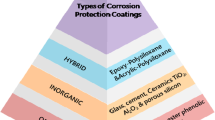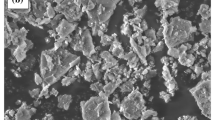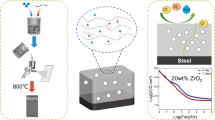We describe an electrochemical method for the formation of composite coatings and foils based on copper reinforced by nanosized aluminum oxide and propose an approach to the chemical dispersion of aluminum oxide based on the principle “from top to bottom” and a composition of electrolyte guaranteeing the possibility of creation of composite materials with different contents of the modifying phase. The influence of the concentration of aluminum oxide in the electrolyte on the physicomechanical properties of the reinforced foil is established. The increase in the strength (and various other physicomechanical characteristics) of the synthesized composite materials is recorded.



Similar content being viewed by others
References
R. H. J. Hannick and A. J. Hill (editors), Nanostructure Control of Materials, Woodhead Publishing (2006).
S. V. Volkov, E. P. Koval’chuk, V. М. Ohenko, and О. V. Reshetnyak, Nanochemistry, Nanosystems, and Nanomaterials [in Ukrainian], Naukova Dumka, Kiev (2008).
C. T. J. Low, “Electrodeposition of composite coatings containing nanoparticles in a metal deposit,” Surf. Coat. Technol., 201, 371–383 (2006).
R. S. Saifullin, Inorganic Composite Materials [in Russian], Khimiya, Moscow (1983).
B. D. Summ, “Colloid-chemical aspects of nanochemistry—from Faraday to Prigogine,” Vest. Mosk. Univ. Khim., 42, No. 5, 300–305 (2001).
P. A. Rehbinder, Surface Phenomena in Disperse Systems. Colloid Chemistry. Selected Works [in Russian], Nauka, Moscow (1978).
L. J. Broutman (editor), Metallic Matrix Composites. Composite Materials Series, Vol. 4: Academic Press, New York (1974).
T. Fujii and M. Zako (editors), Fracture Mechanics of Composite Materials [Russian translation], Mir, Moscow (1982).
B. V. Knorozov, L. F. Usova, А. V. Tret’yakov, et al., Technology of Metals and Materials Science [in Russian], Metallurgiya, Moscow (1987).
V. V. Panasyuk, Mechanics of Quasibrittle Fracture of Materials [in Russian], Naukova Dumka, Kiev (1991).
G. A. Malygin, “Plasticity and strength of micro- and nanocrystalline materials,” Fiz. Tverd. Tela, 49, No. 6, 961–982 (2007).
Author information
Authors and Affiliations
Corresponding author
Additional information
Translated from Fizyko-Khimichna Mekhanika Materialiv, Vol. 50, No. 5, pp. 23–28, September–October, 2014.
Rights and permissions
About this article
Cite this article
Sakhnenko, М.D., Ovcharenko, О.О., Ved’, М.V. et al. Physicomechanical Properties of Cu −Al2O3 Electroplating Compositions. Mater Sci 50, 646–652 (2015). https://doi.org/10.1007/s11003-015-9766-3
Received:
Published:
Issue Date:
DOI: https://doi.org/10.1007/s11003-015-9766-3




